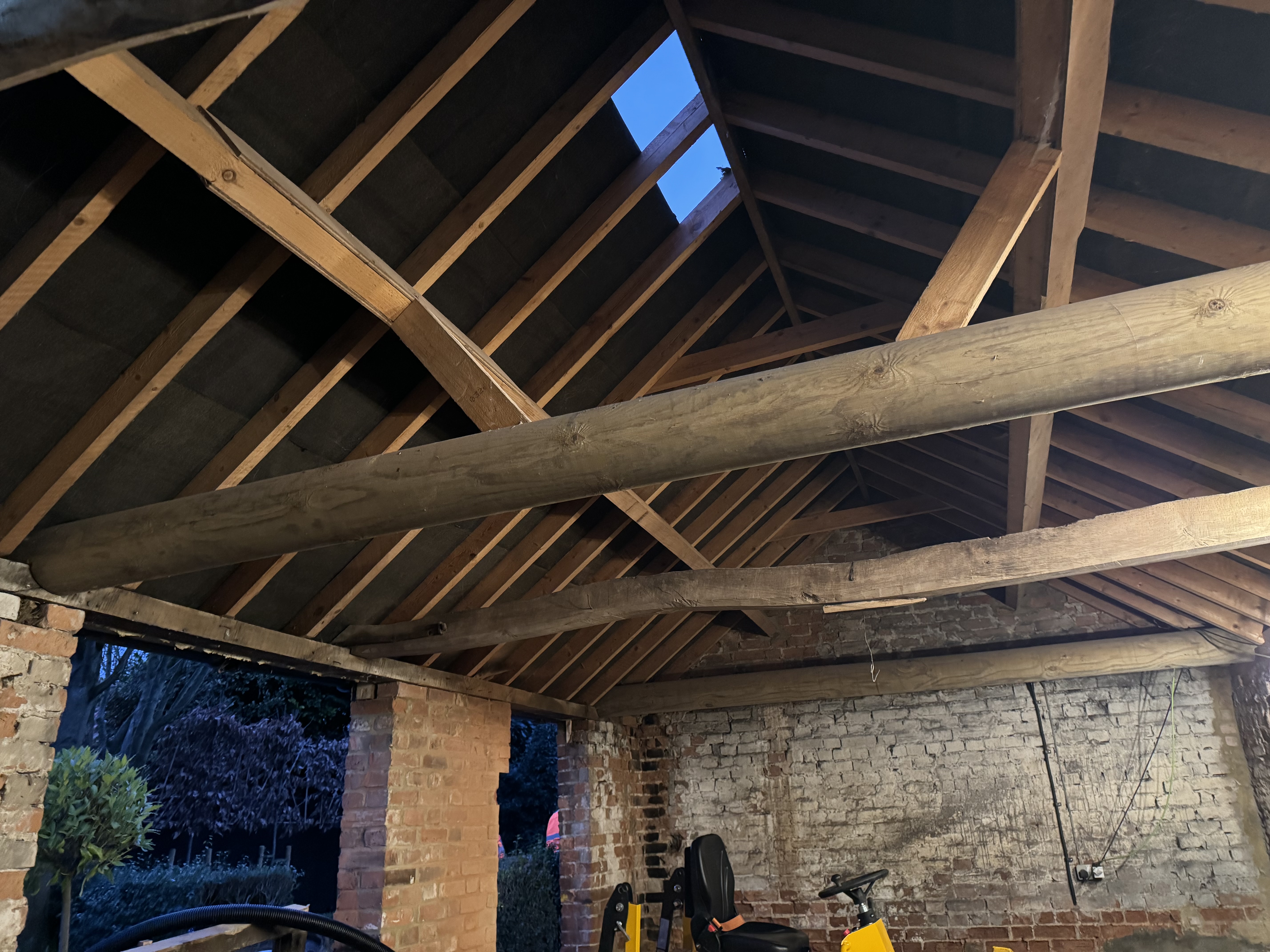Hand cut roof
 A Hand cut roof is defined as a roof that is formed on site from indiviual timber elements.
A Hand cut roof is defined as a roof that is formed on site from indiviual timber elements.
Traditional hand cut roofs are predominantly formed of common rafters that span from a ridge board to purlin (singlular or multiple) to eaves level. The purlin is usually supported from a high level binder, with notch to accept the purlin or it is supported off raking purlin props, bearing to notches in ceiling joists. Where a high level binder suppports the purlin, the binder is usually affixed back to a rafter pair, with the rafters being larger than the common rafters, due to the additional point load from the binder. Where purlin props support the binder, they bear -at an angle, perpendicular to the pich of the roof- into a notch set in a ceiling joist.
An alternative to the above is the support of timber purlins off timber trusses, set at suitable centres. The trusses however are not formed in-situ and are instead lifted into position, prior to "hand cutting" the remainder of the roof into place.
Purlins are typically "Scarf jointed" at the head of supports.
The aim of a traditional hand cut roof is to split forces into Horizontal and vertial components, so that primary supporting elements (Binder/ rafter pairs) or ceiling joists do not have to carry the full load in bending/ flexure, thus reducing section sizes.
Featured articles and news
Key points for construction at a glance with industry reactions.
Functionality, visibility and sustainability
The simpler approach to specification.
Architects, architecture, buildings, and inspiration in film
The close ties between makers and the movies, with our long list of suggested viewing.
SELECT three-point plan for action issued to MSPs
Call for Scottish regulation, green skills and recognition of electrotechnical industry as part of a manifesto for Scottish Parliamentary elections.
UCEM becomes the University of the Built Environment
Major milestone in its 106-year history, follows recent merger with London School of Architecture (LSE).
Professional practical experience for Architects in training
The long process to transform the nature of education and professional practical experience in the Architecture profession following recent reports.
A people-first approach to retrofit
Moving away from the destructive paradigm of fabric-first.
International Electrician Day, 10 June 2025
Celebrating the role of electrical engineers from André-Marie Amperè, today and for the future.
New guide for clients launched at Houses of Parliament
'There has never been a more important time for clients to step up and ...ask the right questions'
The impact of recycled slate tiles
Innovation across the decades.
EPC changes for existing buildings
Changes and their context as the new RdSAP methodology comes into use from 15 June.
Skills England publishes Sector skills needs assessments
Priority areas relating to the built environment highlighted and described in brief.
BSRIA HVAC Market Watch - May 2025 Edition
Heat Pump Market Outlook: Policy, Performance & Refrigerant Trends for 2025–2028.
Committing to EDI in construction with CIOB
Built Environment professional bodies deepen commitment to EDI with two new signatories: CIAT and CICES.
Government Grenfell progress report at a glance
Line by line recomendation overview, with links to more details.
An engaging and lively review of his professional life.
Sustainable heating for listed buildings
A problem that needs to be approached intelligently.
50th Golden anniversary ECA Edmundson apprentice award
Deadline for entries has been extended to Friday 27 June, so don't miss out!
CIAT at the London Festival of Architecture
Designing for Everyone: Breaking Barriers in Inclusive Architecture.
Mixed reactions to apprenticeship and skills reform 2025
A 'welcome shift' for some and a 'backwards step' for others.


























